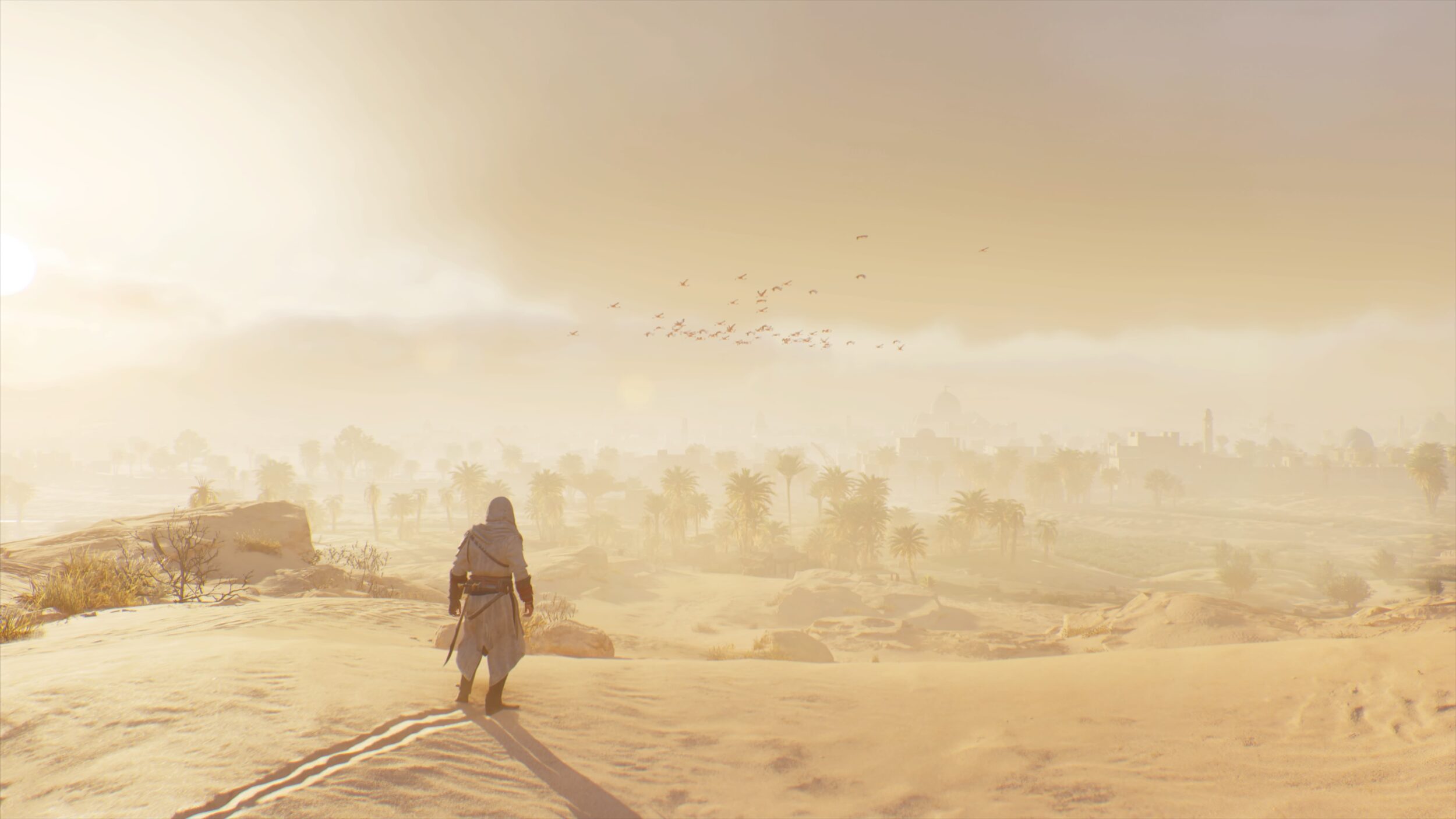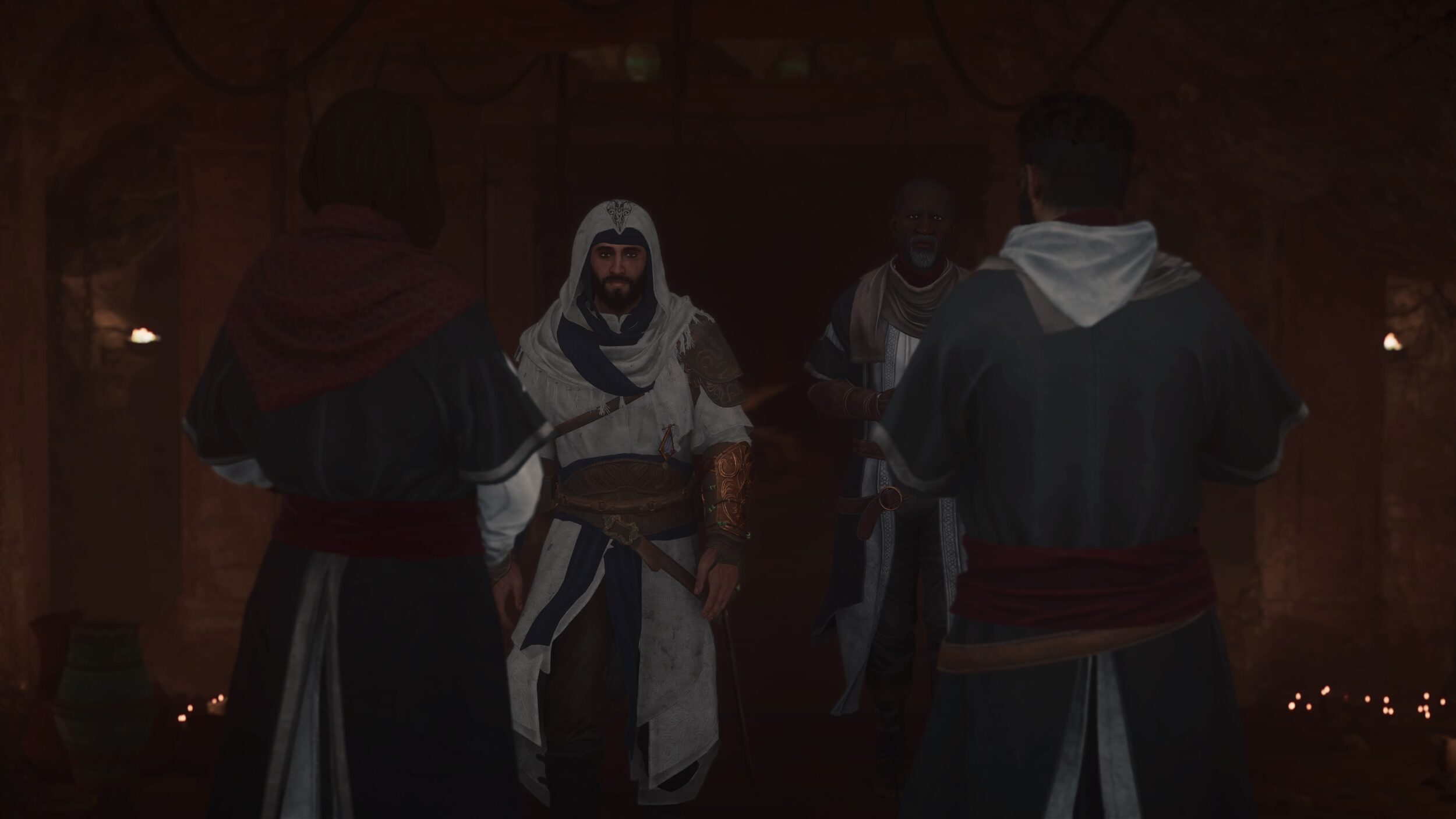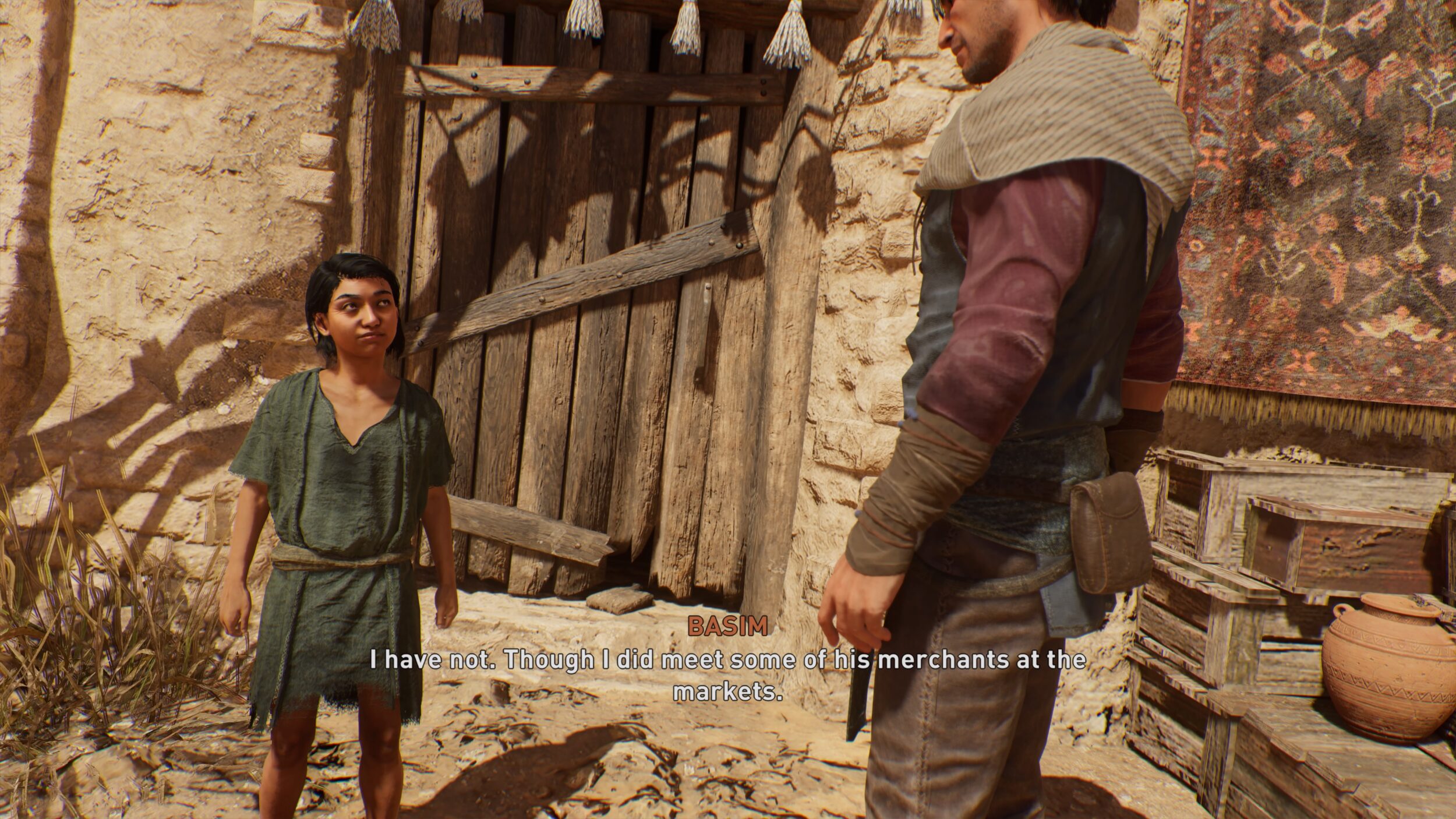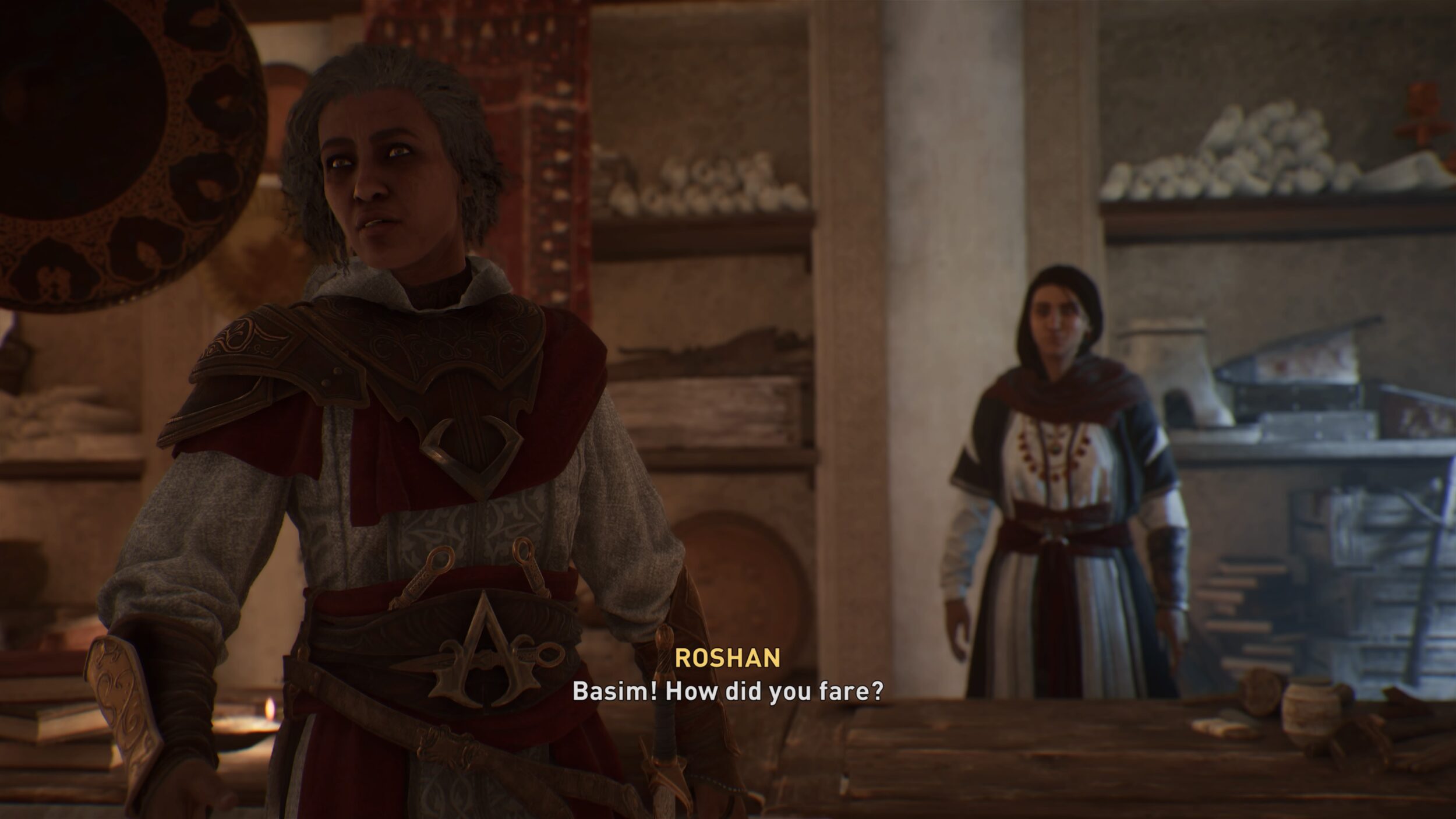The Assassin’s Creed franchise returns with Assassin’s Creed Mirage, a prequel of sorts to Assassin’s Creed Valhalla telling the story of Basim, during his time as a street thief, and on to his early career with the Hidden Ones in Baghdad. This “love letter” to the original game aspires to return what made the series beloved by its fans, with better parkour, a similar level design, and approach to its missions. Did they succeed? Let’s find out.
Assassin’s Creed Mirage is widely believed to be the final game that will release on last generation consoles, capping a massive six-title adventure that started during Revolutionary Paris, and spans Victorian London, ancient Egypt, very ancient Greece, Viking invasion England, and now finally, Abbasid Baghdad. In those six titles, the franchise has drastically changed major aspects of the gameplay, and even delved pretty hard into precursor civilizations. So much so that the aura of mystery that the older games possessed is barely there. The parkour, once a staple of the franchise, was toned down in huge part because the architecture of the periods that the games were set, weren’t exactly free-running friendly. But by far the biggest change was that the story and mission progression has spanned into epic proportions. Where before you are limited to a major city and probably two other locations, the so-called RPG trilogy (Origins, Odyssey, and Valhalla) let you play on entire countries.

A More Focused Experience….
Focusing on Baghdad and Basim’s story makes Mirage a very refreshing respite. While the map was still considerably large, it isn’t massive. And while the free-running isn’t on the same level as with Assassin’s Creed Unity (which a lot of fans seem to want), it is still proper free-running, in an environment that is very conducive to parkour. The mission progression worked around your targets, the Order of the Ancients. You would have to investigate clues, hunt for minor targets, and assist allies before getting a chance at the main Order member. It worked very much like in the first Assassin’s Creed game. Side quests still exist, though not in abundance like in Valhalla, and very rarely do they take me out of my focus on the missions.
Assassin’s Creed Mirage can be finished in around 20 hours for the main story, and approximately 30 hours for completionists. I finished the main story at around 23 hours, but I usually take my sweet time clearing locations stealthily. Speed-runners can probably finish everything in 15 hours. While that might sound too short, for a story-driven game, it’s quite alright. Not all games should be 50 hour epics.
I very much prefer this approach every now and then. While I enjoyed my time with Odyssey and Valhalla, I did come to a point where the massive amount of content was just too tiring to explore. For once, since Origins, everything was just confined to Baghdad and surrounding regions that aren’t massive. Everything that had to happen, happened there.

Running Free…..
The free-running in the series has become a bit of an issue among fans. After three games of where the free-running has somewhat receded in priority and purpose (mainly because the settings weren’t exactly tailored to free-running), fans just wanted to see Assassin’s Creed Unity levels of parkour once again. Although Mirage doesn’t offer the same kind of verticality, they did bring back a lot of what made parkour in Assassin’s Creed fun.
Basim is quite fast, and that is apparent in my ability to outrun guards most of the time than I would in other Assassin’s Creed games not named Unity. The game still featured the same simplified controls of the last three games, but now it is easy for Basim to leap over low objects, and quickly move from point A to point B using his athleticism. The game also brought back tons of animations that really made parkour fun. I must emphasize though, that this isn’t Unity, and you shouldn’t find Assassin’s Creed Unity in this game because you won’t find it outside of familiar looking animations and movements. Parkour is fun, but you should temper your expectations.

Since Basim is a master thief, stealing gets a bit of a gameplay change here. Pickpocketing initiates a mini-game where you need to hit on a green zone to pick-pocket successfully. Fail and the victim will call the guards on you. This option can be toggled in the Accessability options however, if you don’t want to deal with that stuff.
My nitpick is that sprinting can be a bit confusing. The difference between sprinting and normal running animations can be so subtle I couldn’t figure out whether I’m still sprinting, or if I’m back to normal running for some reason. And that’s important because you have to be sprinting to do some parkour animations. Also, we really need to bring back side-ejects. There are times where I could have used a side-eject but was stuck because I couldn’t. Parkour is back, but we could make it better.

Fight or Flight
Combat has been changed to encourage a more stealthier approach. Although if you have to fight, you have to get your wits about you. Enemy attacks are color-coded. Yellow for light attacks, and red for heavy attacks. You can parry light attacks, but you can only dodge the red ones. Oh, and certain enemies have armor so you can only damage them by attacking them from behind.

Attacks and dodges all reduce stamina. Once you run out of stamina, you can’t do anything and you’ll be open to attacks. What you can do, is to parry light attacks to open the enemy either for a hit, or an instant kill. However, I found parrying quite a challenge to get the timing down pat. It’s probably a skill issue on my part, but it does take a while to get used to. However, mastering combat can make you quite formidable.
Still, it is easy to be surrounded in enemy-heavy places. In this case, it would be smarter to try and get away, which should be easy given that Basim is faster and the level design encourages free-running.
Staying in the Shadows…
One thing I loved about Assassin’s Creed Mirage is that you can play as an Assassin (Hidden One) once more. This means stealth kills. Lots and lots of stealth kills. I can spend an hour trying to infiltrate and dismantle guarded locations. And then, when the guards have respawned, I go back there and do it again. Some missions force you to be creative: hire mercenaries to make a distraction for you, or paying a merchant to help you get inside a prison, or find gaps in the walls that will help you get in.
It is fun because you can assassinate from cover and there’s a lot of assassination animations. There are lots of hiding spots, that can aid you in infiltrating, killing guards, and then hiding the body. There are certain times where you can eavesdrop on conversations as well, although unfortunately those are limited to missions. Still, there is a renewed emphasis in staying “in the dark”, rather than just go through the main door and kill everything that moves like Eivor and Kassandra did in the previous games.

An RPG this isn’t….
Assassin’s Creed Mirage is not an RPG game. Instead, abilities are tied to story progression. Assassin Focus, that controversial multi-kill mechanic, can only be accessed from a certain point in the story. You do earn skill points to unlock further abilities so there is a certain grind, but nowhere near what it had been since Origins. In fact, I finished the game with one skill tree barely invested in.
The skills I unlocked do help me a lot especially the combat, and Assassin Focus isn’t as OP as some fans feared. All in all, I found it pretty refreshing that I don’t have to be on a certain level for areas and missions, that I can proceed with investigations as they opened for me without worrying if an enemy type can insta-death me so long as I kept to the shadows.
There are gear chests peppered throughout the map, though they’re not as extensive as Valhalla’s. You can transmog gear if you want to use the perks of one set while using the aesthetics of another, but to be honest, I didn’t feel the difference. I used the same outfit from the time Basim became a Hidden One until the last mission where I unlocked a certain costume (which is cosmetic only). You can upgrade both armor and weapons, but it isn’t as deep as the RPG games.

Like all Assassin’s Creed games, there is an Isu set you can unlock by collecting “shards”. The stats are formidable, but not overpowered, and the Isu sword requires half of your life bar so that it can give you 50% more damage. It’s cool, but it doesn’t make you a god of war, and like with that Isu sword, it could come back to bite you in the end.
The Hidden One….
Assassin’s Creed Mirage tells the story of Basim, the surprise final boss of Assassin’s Creed Valhalla, during his time as a street thief in the streets of Anbar, to his education, initiation, and early career with the Hidden Ones. Running parallel to this storyline is the fact that Basim is being tormented of dreams about a jinn, and that these dreams start to increase in intensity as he kills his targets.
Valhalla introduced the concept of “reincarnated” Isu, with Basim being Loki in the past life, Sigurd being Tyr, and Eivor being Odin. Mirage does not dwell on how that happened, but focuses on how Basim was able to “reconcile” with his past self. Like any Assassin’s Creed game, the final chapter contained a lot of twists and turns, with one in particular making me go WTF, and will probably be talked about among Assassin’s Creed fans for months. I still have some questions from the ending, but I’m pretty happy with how it turned out.

That said, I felt the story started pretty slow, and street thief Basim sometimes gets on my nerves. However, Basim the Hidden One can be very charming. If you are wondering why Basim in Valhalla has a different demeanor than Mirage’s Basim (besides the fact that he was older in Valhalla), well, the story answers that somewhat im the end. The Order of Ancients are also pretty OK as a whole, but they lack the usual emotional punch. Probably because I was used to most targets having some personal beef with the main character in previous games. Mirage hearkens back to the first game where Altair had to kill targets that were given to him, and that can be good or bad depending on the player.
I enjoyed playing as Basim, and I enjoyed doing missions from the Bureau, but many of the other charactes just did not hit it for me. Ali Ibn Muhammad is a jerk, most Hidden Ones not named Roshan are just minor characters, and while I find the head Ancient One “Al Bahamut” to be fine, the character isn’t as memorable as other antagonists in the series. I did love Nehal and Roshan, and the twist involving Nehal was pretty good, though Roshan’s was predictable.
Technically still Last Gen…
Assassin’s Creed Mirage still feels like a last generation game, for better or for worse. Visually, it feels like an upgrade from Valhalla’s, but not by much. I did not experience any noticeable frame-rate drop, but I don’t have technical data to validate that experience. I do feel that if Ubisoft is really leaving the last generation behind for the next game, then they should take advantage of current gen’s power. The cut-scenes should be more seamless, and maybe invest in better face capture. Or if they’re already doing that, maybe improve it a bit more? Some in-game facial animations are wooden. The voice acting is a bit inconsistent as well, with fine performances from Basim, Roshan, and Nehal, but some other minor characters are a bit “off”.
I did not experience a lot of visual bugs in the game, but I did have some issue with collision detection, and Basim not responding to my controls. I also noticed some NPCs materializing out of thin air, which is something that should have been fixed in the franchise at this point. It’s not Assassin’s Creed Unity level of bad, but it could be jarring to those aiming for “immersion”. The character models do look a bit better and more detailed than Valhalla’s, but that’s likely due to the game having far fewer armor and costumes for Basim, whose outfits are probably the most detailed in the game, right down to the talisman hanging at his back. There isn’t much variety in outfits for NPCs though, although Baghdad has plenty of NPC characters walking around, making the streets feel more alive.

As for the architecture, I found it extremely beautiful, with intricately detailed walls, especially in mosques. The Bazaar was a delight, because it features a wide assortment of goods being sold, even though you can’t interact with most of it.
Just to be clear, I am not expecting a dramatic leap as what happened from Assassin’s Creed Rogue and Assassin’s Creed Unity, but the visuals in Ubisoft games are starting to look the same throughout franchises, even with the shift in the hardware. Even Just Dance 2023, which was current gen only, didn’t look much different from its previous installments. I suppose I’m just nitpicking because I really do care about the franchise, and I’d like Ubisoft to challenge itself with their games’ visuals.
Conclusion
Assassin’s Creed Mirage is a worthy entry to the franchise manily because of its streamlined, story-driven approach, supported by a likeable character, and a good effort by Ubisoft to promote the Abbasid culture via the Codex. It shows that the old formula that was once at the heart of the series, can still make for good stories and games. Despite a bit of a struggle with the controls, and some unfortunate mishaps because of poor collision detection, it still makes for a fun, albeit short run.

It doesn’t push anything forward especially in the graphics department, and it’s pretty hard to relate to some characters and targets, but in general, the game is just fine. Hopefully, this “love letter” to the first Assassin’s Creed won’t stay as a mere tribute and it convinces Ubisoft to make similar story-focused games in the future. I’d give it a solid 8 out of 10.


